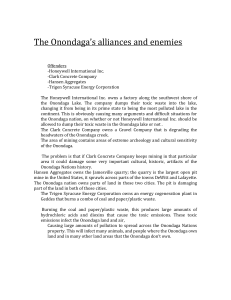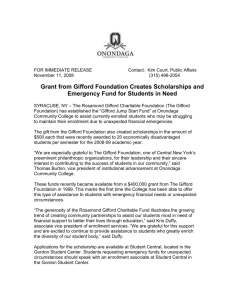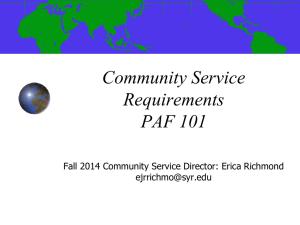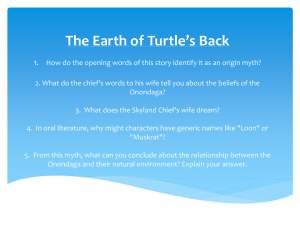Investigating the historical ecology of Onondaga Lake
advertisement
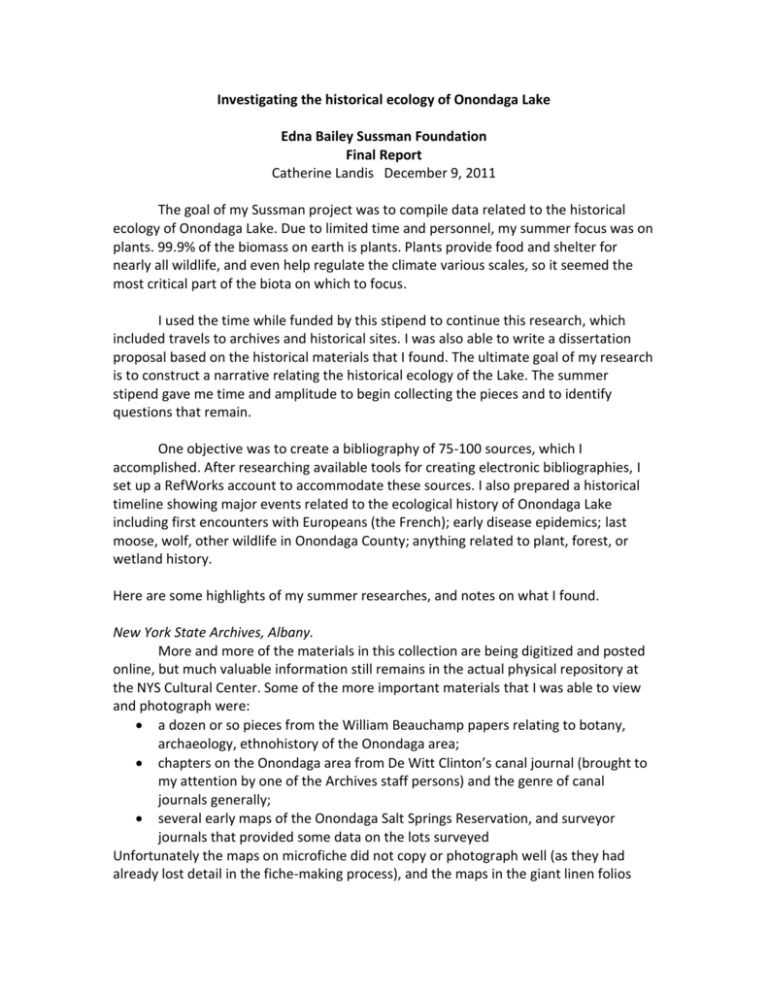
Investigating the historical ecology of Onondaga Lake Edna Bailey Sussman Foundation Final Report Catherine Landis December 9, 2011 The goal of my Sussman project was to compile data related to the historical ecology of Onondaga Lake. Due to limited time and personnel, my summer focus was on plants. 99.9% of the biomass on earth is plants. Plants provide food and shelter for nearly all wildlife, and even help regulate the climate various scales, so it seemed the most critical part of the biota on which to focus. I used the time while funded by this stipend to continue this research, which included travels to archives and historical sites. I was also able to write a dissertation proposal based on the historical materials that I found. The ultimate goal of my research is to construct a narrative relating the historical ecology of the Lake. The summer stipend gave me time and amplitude to begin collecting the pieces and to identify questions that remain. One objective was to create a bibliography of 75-100 sources, which I accomplished. After researching available tools for creating electronic bibliographies, I set up a RefWorks account to accommodate these sources. I also prepared a historical timeline showing major events related to the ecological history of Onondaga Lake including first encounters with Europeans (the French); early disease epidemics; last moose, wolf, other wildlife in Onondaga County; anything related to plant, forest, or wetland history. Here are some highlights of my summer researches, and notes on what I found. New York State Archives, Albany. More and more of the materials in this collection are being digitized and posted online, but much valuable information still remains in the actual physical repository at the NYS Cultural Center. Some of the more important materials that I was able to view and photograph were: a dozen or so pieces from the William Beauchamp papers relating to botany, archaeology, ethnohistory of the Onondaga area; chapters on the Onondaga area from De Witt Clinton’s canal journal (brought to my attention by one of the Archives staff persons) and the genre of canal journals generally; several early maps of the Onondaga Salt Springs Reservation, and surveyor journals that provided some data on the lots surveyed Unfortunately the maps on microfiche did not copy or photograph well (as they had already lost detail in the fiche-making process), and the maps in the giant linen folios were difficult to photograph. So while I recorded information from these maps, I’m not sure at this point how much I can use them in my dissertation. Ganondagan State Historic Site, Victor, NY Though a reconstruction of a Seneca (and not Onondaga) site, I learned much at Ganondagan about the seventeenth century Haudenosaunee culture that would have been similar at Onondaga, and therefore picked up important clues about native peoples’ relationships to land and plants. The restored longhouse gave us a first-hand sense of how people lived. From an ethnobotanical perspective I saw the use of many local plants including elm, cedar, hickory, ash, sassafras, arrowwood, Jerusalem artichoke, smooth sumac, corn, beans, squash. These uses parallel those occurring at Onondaga during the same time frame (late 1600s). This site also has a remarkable bookstore with wide selection of ethnobotanical sources for sale. While none of this information is specific to Onondaga Lake, much of it can be applied there in terms of the subsistence lifeways practiced, relating to both plants and animals (e.g. beaver were largely removed from the Great Lakes watershed by 1640). Onondaga Historical Association Here I combed through the James Geddes papers, including letters from the late 1700s when Geddes lived in what was then the village of Geddes near Harbor Brook. Based on these valuable sources I prepared a 3 page article for the Onondaga Nation newsletter that discussed the early white pine forests harvested by Geddes’ sawmill in Fairmount, and the extensive use of timber (local and shipped in) for infrastructure and fuel related to the salt industry. I also investigated the George Geddes papers, which contained sporadic but valuable information. All of this material will provide content for my dissertation. American Philosophical Society, Philadelphia I visited this site on the basis of a single map, from about 1800, of Onondaga Lake. This map has been invaluable to my research since, unlike most other maps of the area, it includes timber species as well as locations of both potable and salt springs around the lake. At APS, I was able to see the original copy of this map, but unfortunately there was little information available to shed light on its cartographer or the date it was made. Despite help from APS staff I found no other materials of similar value related to Onondaga Lake. I did, however, copy a early map of the Erie Canal because it showed remaining wetland areas (shaded) around Onondaga Lake that corresponded to later sites of industrial development. Another key piece was a map hand-sketched by Frederick Pursh, describing his 1807 trip to Onondaga and Vermont. Academy of Natural Sciences, Philadelphia Probably the most important work I did all summer concerned the travels of Frederick Pursh to Onondaga Lake in 1807. At ANS I saw the Pursh collection (it’s stored with the plant specimens from the Lewis and Clark expedition) and, equally important, made the acquaintance of Dr. Alfred Ernest Schuyler, Curator Emeritus of the collection. He spent much time helping me navigate the Pursh collection and also in updating some of the plant names from Pursh. The list has about 200 species of plants noted in Pursh’s journal as occurring around Onondaga Lake in 1807. The list is valuable in its own right, but also as a key to both environmental conditions around the lake at the time, and indigenous use of plants for food and medicine. McVaugh (1936), as well as Faust and Roberts (1983), studied plant material Pursh collected from Onondaga. Based on the herbarium specimens, these researchers compiled species lists using modern nomenclature. I have found no source, however, that systematically “mines” Pursh’s 1807 journal (Pursh 1869) in order to highlight the species Pursh only observed, but did not collect, during his Onondaga visit. This group would include plants having unique ecological and cultural value such as Kentucky coffee-tree (Gymnocladus dioicus ), ground-nut (Apios americana), and New Jersey tea (Ceanothus americanus), all of which Pursh found near Onondaga Lake. Future work I combined much of this information into my dissertation proposal. The proposal’s themes are based largely on historical material I collected over the summer while on the Sussman; they might be called “lessons from history”: 1. Change is pervasive in a system such as Onondaga Lake, and the human imprint has marked the lake for 500 years and more. 2. The interaction between humans and place is not deterministic, but rather a dynamic dialectic, resulting in landscapes that are cultural ecosystems. 3. Humans can produce and help to maintain sustainable, diverse ecosystems. Given constraints and unknowns of a rapidly changing climate, history can help us look beyond species lists (such as Pursh’s) to the cultural wisdom that allowed people to survive here over millennia. This knowledge can take us in the direction of blurring lines between “cultivated” and “wild”, “nature” and “culture”, “land” and “water”, “natural” and “civilized.” These distinctions were less sharply drawn in the indigenous landscape, based on my reading to date. This “blurred logic” (as opposed to fuzzy logic) has also been referred to as liminal thinking (Stein 2008). It could point us in the direction of long-term sustainability and the vision of land as home. Many thanks to Sussman funding for sustaining me while I dug through the eco-cultural memory bank, unearthing important treasure. Literature cited Faust, M.E. and N.R. Roberts. 1983. The salt plants of Onondaga Lake, Onondaga County, New York. Bartonia 49:20-26. McVaugh, R. 1936. A study of the plant-collections made by Frederick Pursh during a trip to New York and Vermont in 1807. Bartonia 17:24-32. Pursh, F. 1869. Journal of a botanical excursion in the northeastern parts of the states of Pennsylvania and New York during the year 1807. Brinckloe and Marot, Philadelphia, PA. Stein, N. R. 2008. Dichotomies and the “maize debate”: in late woodland and contact period southern New England. In Current northeast paleoethnobotany II, ed. by John Hart, pp. 61-72. New York State Museum Bulletin 512. University of the State of New York, State Education Dept., Albany, N.Y.


